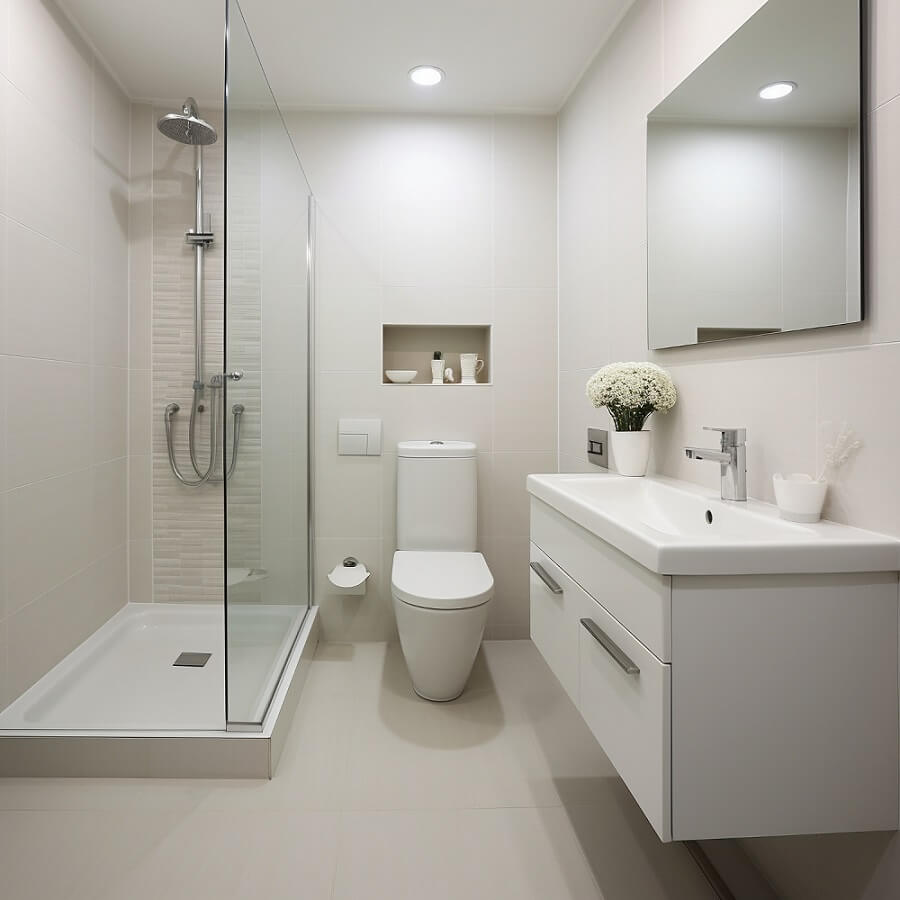When you are thinking about a new home construction or a remodeling project, it can be overwhelming to determine where to start. The planning phase involves careful consideration of numerous details, including even the dimensions or size of your bathroom door.
According to local codes, the minimum width for a bathroom door ranges from 24 to 32”. 24-inch doors are normally allowed only for existing bathrooms, while new constructions generally require wider doors. Bathroom doors are commonly available in widths up to 36 inches. In terms of height, the minimum bathroom door height falls between 78 and 80”, as per local codes. However, the most commonly used door size for bathrooms is 32” wide and 80” tall.
This comprehensive article provides essential information to guide you in selecting the most suitable bathroom door for your home. It covers important aspects such as local codes that regulate the size of bathroom doors, along with additional facts and suggestions that are crucial to consider when determining the appropriate dimensions for your bathroom door.
By reading this article, you will gain a thorough understanding of bathroom door sizing, ensuring that you make an informed decision for your home
What Codes Govern Bathroom Door Sizes?
The regulations governing bathroom door sizes can be different depending on the state and local codes. While the International Residential Code (IRC) primarily focuses on egress doors, there are specific guidelines in certain states to consider when selecting the size of an interior door, including bathroom doors.
For instance, in Wisconsin, according to the Interior Door Size Regulations, all interior doors must have a minimum height of 80 inches. Additionally, they should be 32 inches wide or provide a clear space of at least 30 inches when fully opened.
In contrast, the Michigan Interior Door Size Regulations state that interior doors should not be narrower than 24 inches and must have a minimum height of 78 inches. Exceptions to this rule exist for doors leading to spaces with a floor area of less than 10 square feet
As the local codes can vary significantly when it comes to interior door sizes. To ensure compliance, it is recommended to consult your state’s building guidelines before finalizing the size of your bathroom door for your home.
Smallest Allowed Door for a Bathroom
Minimum Door Width
The smallest allowable width for any interior door, including the bathroom door, typically falls within the range of 24 to 32 inches, depending on the specific local building codes.
Minimum Door Height
The minimum height for an interior bathroom door is typically between 78 and 80 inches, as specified by local codes.
Most Common Bathroom Door Size
The most common size for a bathroom door in many homes is a height of 80 inches and a width of 32 inches.
However, certain states may not impose restrictions on the size of bathroom doors, allowing for taller options of more than 80”. Just remember that custom-made doors exceeding 80 inches in height can be more expensive compared to standard-sized doors.
For accessibility and convenience, it is common for people to choose bathroom doors wider than 30 inches. This ensures that furniture and other larger items can easily be moved in and out of the bathroom without hassle. Moreover, a door with a width greater than 30 inches enables easier movement for individuals and make it easy to furnish your bathroom.
Additionally, it is important to consider that a bathroom door with a width greater than 30 inches will make movement easier for a larger number of individuals entering and exiting the bathroom.
Why Should the Bathroom Door Be Wider Than 24″?
The width of a bathroom door should ideally be wider than 24 inches for several reasons. While 24-inch doors may exist in some homes, it is important to note that installing a new door with this width is typically not permitted, except in cases where the existing structure cannot accommodate a larger door.
One primary reason for opting for a wider bathroom door is to ensure easy accessibility. A 24-inch door can cause challenges when moving through the doorway due to its small size.
While it may be deemed acceptable for spaces like pantries, closets, or guest rooms, areas with a higher volume of people, such as bathrooms, are recommended to have wider doors. This allows individuals to move through the doorway more efficiently and comfortably.
It is technically possible for a person to fit through a 24-inch wide door. If you are carrying a load of laundry or towels into the bathroom, it will be quite challenging due to the restricted space.
Additionally, individuals using walkers or wheelchairs will find it virtually impossible to navigate through such a narrow opening.
To ensure easy access for all individuals, including those with disabilities, it is important to consider the specific guidelines outlined by the Americans with Disabilities Act (ADA) regarding door sizes.
Door Size Compliant With Americans With Disabilities Act
When choosing a bathroom door for your home, it is necessary to prioritize accessibility, especially for individuals with disabilities or those who use wheelchairs or walkers. Standard or small-sized doors may not offer enough space to accommodate their needs.
According to Section 404 Doors, Doorways, and Gates of the ADA, the following door sizing requirements should be considered. Here is the direct quote from it:
“404.2.3 Clear Width. Door openings shall provide a clear width of 32 inches (815 mm) minimum. Clear openings of doorways with swinging doors shall be measured between the face of the door and the stop, with the door open 90 degrees. Openings more than 24 inches (610 mm) deep shall provide a clear opening of 36 inches (915 mm) minimum. There shall be no projections into the required clear opening width lower than 34 inches (865 mm) above the finish floor or ground. Projections into the clear opening width between 34 inches (865 mm) and 80 inches (2030 mm) above the finish floor or ground shall not exceed 4 inches (100 mm)”
Section 404 also includes two exceptions to these requirements. These include:
- In alterations, a projection of 5/8 inch (16 mm) maximum into the required clear width shall be permitted for the latch side stop.
- Door closers and door stops shall be permitted to be 78 inches (1980 mm) minimum above the finish floor or ground.
For further details and information on making your home more accessible, you can visit the Americans with Disabilities Act website.
Additionally, when installing a bathroom door specifically for wheelchair or walker access, consider factors such as the swing direction of the door and a lock that can be opened from the outside in case of an emergency.
Guidelines for Bathroom Door Thickness
Typically, bathroom doors have a standard thickness of 1 ⅜”. However, there are various options available in the market, including doors with thicknesses of 1 ½”, 1 ⅝”, and 1 ¾”.
Oversized doors, which exceed dimensions of 90″ in height and 36″ in width, often have a greater thickness than standard doors.
When it comes to glazed doors, the thickness may differ from the above-mentioned measurements.
The most common type of glass used for bathroom doors has a thickness of ½”, although thicker glass options ranging from ¾” and beyond are becoming more common.
As the height of the bathroom door increases, it becomes necessary to use thicker glass to ensure stability. Also, the door itself must also be thicker to accommodate the increased glass thickness.
All Bathroom Door Sizes
Here is a list of common bathroom door sizes that are typically available at local home improvement stores:
- 24” x 78”
- 30” x 78”
- 36” x 78”
- 24” x 80”
- 28” x 80”
- 30” x 80”
- 32” x 80”
- 34” x 80”
- 36” x 80”
Size Requirements for Bathroom Door Leading Outside
In certain situations, bathrooms may have both an internal door and an egress door leading outside.
An egress door serves as an accessible exit from a building during emergencies. However, in the case of a bathroom, it is often installed to provide convenient access from the outside, avoiding the need to pass through the house when, for example, you are dirty from gardening or wet from a swim in the pool.
Some individuals even opt for outside showers connected to a courtyard that can be accessed through the bathroom’s external door.
If you have a bathroom door leading outside, it is important to adhere to the size requirements outlined in Section R311 of the International Residential Code (IRC). According to these regulations, an egress door should have a minimum width of 32″ and a height of 78″.



